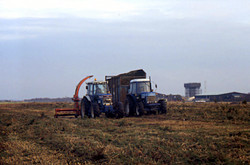
Heathland management overview
The management of the heathland areas involves periodic mowing, cutting and scraping to complement the grazing. The intention is to create a diverse age and height structure in both heather-dominated and gorse-dominated communities to benefit the widest variety of species, from beetles on bare ground through nesting birds in mature heather to bird perches on single trees. Cutting is also intended to prevent common gorse becoming too dominant.
Burning is not currently (2013) used because it returns accumulated nutrients to the soil. For large areas of gorse, it is preferable to cut and remove the arisings to mainatin the impoverished nature of heathland soils. However burning remains a possible management option for the future.
Heathland management documents
More detail is available in the following documents:
Desirable coverage percentages of each element of the heathland are outlined in Natural England's (2013) Definitions of Favourable Condition for the SSSI areas of the common (see, particularly, table 3a). These will be incorporated in the monitoring regime from 2013 onwards. The amount of cutting, mowing and grazing will be reviewed every year.
A survey of the extent and dominance of gorse and heather was done during winter 2007-08. The map produced from that survey provides a base against which later changes can be measured. An accompanying explanatory document gives details of the survey methods and results.
The current gorse management overview and plan was produced in late 2012.